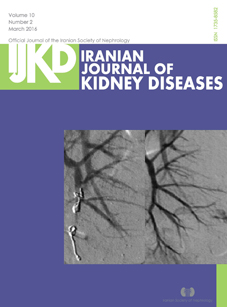Survival Factors in Patients With End-stage Renal Disease in Mazandaran Province, Iran
Abstract
Introduction. Survival analysis for patients with end-stage renal disease and factors influencing their survival is crucial due to the increase in the number of these patients along with their high mortality rate. This study aimed to analyse the survival rate of patients in north of Iran undergoing hemodialysis and to assess factors influencing their survival.
Materials and Methods. A historical cohort study was conducted on 500 patients on maintenance hemodialysis in 3 hospitals of 2 cities (Sari and Babol) in Mazandaran province during a 6-year period from 2007 to 2013. The Cox regression analysis was used to assess the impact of sex, age, education, smoking habit, primary cause of kidney failure, living with family, cardiovascular diseases, weight, age at diagnosis, and age at initiating hemodialysis on survival of the patients.
Results. The median survival time for the 500 hemodialysis patients was 108 months. Death occurred in 174 patients (34.8%). History of smoking, age, being unemployed, being illiterate, and renal cyst, congenital diseases, and unspecified diseases as the cause of kidney failure were the associated factors with survival of the patients. The 1-, 2-, 3-, 5-, 10-, and 12-year survival for these patients was estimated to be 84%, 77%, 71%, 58%, 43%, and 33%, respectively.
Conclusions. This study showed a high level of mortality and poor survival prognosis for patient undergoing maintenance hemodialysis. History of smoking, age, being unemployed, being illiterate, and renal cyst, congenital diseases, and unspecified conditions as the cause of kidney failure were the associated factors with survival of these patients.


